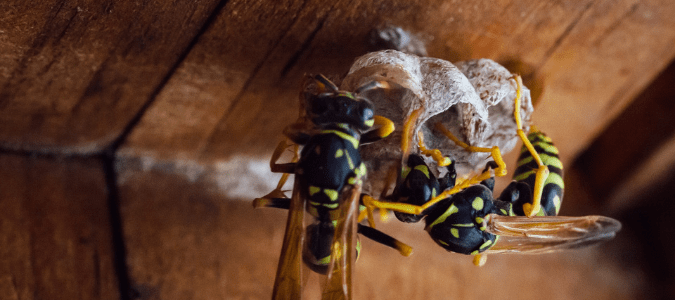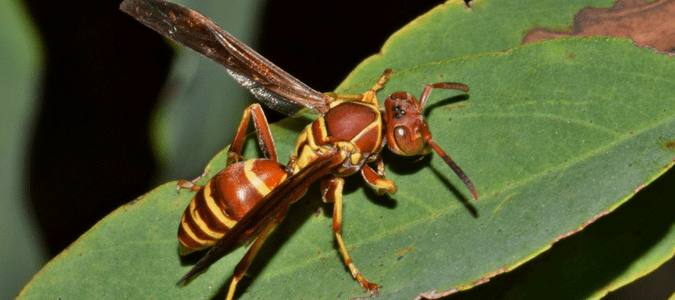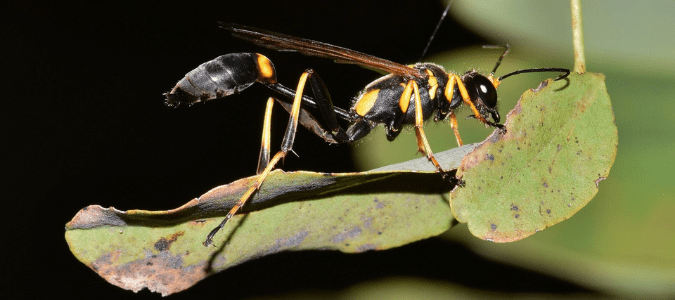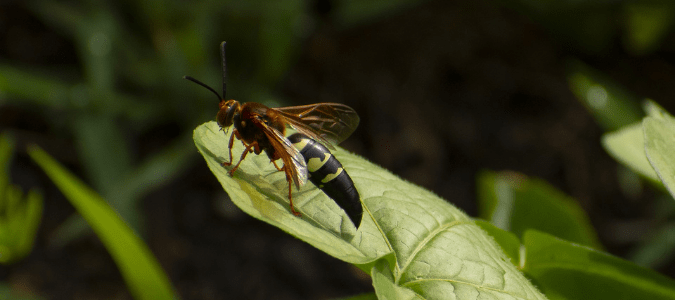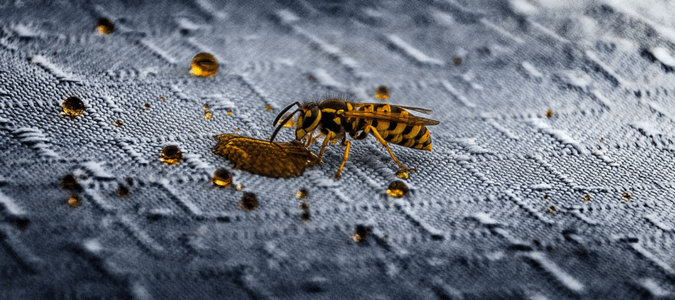For many people, seeing a wasp is cause to scream, duck and run for cover. This is understandable, considering how much it hurts to get stung. Some people are even allergic to stings, making bees and wasps a real danger. But while some types of wasps are aggressive, plenty of others are very unlikely to sting you. Regardless, most of us want to get rid of wasps when we see them. Read on for more information about these insects, including the best ways to get rid of wasps when you see them or their nests around your property.
Are Wasps Beneficial?
Something many people don’t realize about wasps is that they are actually beneficial. Like bees, wasps are pollinators. This means they are an essential part of the process of producing fruits, seeds and more plants. Wasps also feed on caterpillars and other pests that might otherwise destroy our food crops.
For all of these reasons, wasps are incredibly important in our world. They are behind much of the food that humans and other animals eat. This means they aren’t truly pests—except when they create a safety hazard by building a nest too close to where people live.
If you are noticing more wasps around your home and property lately, you probably want to know how to get rid of them. First, it’s a good idea to learn what species of wasp is making its home near yours. That will help you determine how much of a threat it is to you and your family, and how best to get rid of it.
Additionally, sometimes people think a flying insect is a wasp, which is pictured at the top of the blog, when it’s really a bee, which is pictured above. Maybe even more than wasps, bees are extremely important to our world’s wellbeing, and they are also endangered. It’s good to know if you’re dealing with a bee or a wasp before taking steps to eliminate it.
These are the most common wasps you may see buzzing around your property.
Yellow Jackets
Yellow jackets are one type of wasp that people sometimes confuse with bees, since they have yellow and black markings on their bodies, as you can see in the image at the top of the post. But there are some distinct differences between these two insects that can help you tell them apart. One difference is that bees have fuzzy thoraxes—the part of their bodies right behind their heads, where the wings attach. They also have black-and-yellow stripes on their abdomens.
Yellow jackets’ thoraxes are smooth, and their abdomens aren’t striped. Their legs are also mostly yellow, whereas bees’ legs are black with tiny yellow markings. Yellow jackets also have darker, narrower wings than bees’ wings. Additionally, their bodies are usually a little longer than bees’ bodies, at three-quarters of an inch.
Their behavior is one thing that really sets yellow jackets and bees apart. Bees are gentle by nature. They usually stay away from people and don’t normally sting unless they are truly threatened. They might sting, for example, if someone steps on them or otherwise traps them. But bees can only sting once, and they almost never go out of their way to sting someone. They are far more likely to protect themselves by flying away.
Yellow jackets, on the other hand, are highly aggressive. They will fly toward a person and sting them, sometimes repeatedly, even when they aren’t threatened. Yellow jackets are also a danger to bees. They feed on sweet liquids, so they go after the honey found in bees’ nests. All of this means the danger that yellow jackets pose for both people and bees pretty much outweighs any benefits they might have.
Yellow jackets often build their nests on the ground or in hidden spaces, like under eaves or inside a wall void. If you see lots of yellow jackets coming and going, you may not be able to find the exact location of their nest. If you do find a nest, stay well away from it. A group of yellow jackets defending their nest are extra aggressive.
If yellow jackets are nesting near your home, it’s a good idea to call on a pest control professional to handle it. A pro has the right techniques, products and protective gear for the job, saving you and your loved ones potential pain and trouble.
Paper Wasps
Paper wasps are orange or brownish with red or yellow markings, and grow to about an inch long. They build nests out of paper particles that are constructed in clusters of paper-thin tubes. They build their nests hanging from buildings or under eaves, or from tree branches or other plants.
Paper wasps normally don’t sting people and aren’t usually aggressive unless they feel their nests are being threatened. Since they do sometimes sting when protecting their nests, and since their nests are often built up high, it’s a good idea to hire a professional to remove their nests.
Mud Daubers
Mud daubers are a type of wasp that build their nests out of mud. They often build them several feet above the ground on an exterior wall with some shelter. This might be under eaves or an awning over a doorway, or in a garage or barn. It can be scary to duck past a mud dauber nest on your way into your home, but keep in mind that these wasps are very docile. They hardly ever sting people.
Mud daubers are usually black, but their bodies might also be a shiny dark-blue color. They can grow up to an inch long, and the connection between their thoraxes and their abdomens is almost thread-thin. Their nests are tubes of mud built close together. Each tube holds a wasp larva that will tunnel its way out when it hatches.
Even though mud daubers aren’t known to sting people, their nests can sometimes be taken over by other, more aggressive insect pests. This is one reason to have mud dauber nests removed when you find them. A pest control professional can identify the type of wasp you’re dealing with and determine the best way to eliminate them along with their nests.
Cicada Killers
Cicada killers are a type of wasp only spotted around the yard in summer, when cicadas are most active. As their name suggests, cicada killer wasps feed on cicadas. They are very large wasps, almost as big as the insects they kill to eat. This makes them look extra scary, but they actually aren’t aggressive. They rarely sting people. As with all wasp species, the males don’t even have stingers! Only the females sting.
Cicada killer wasps are black with yellow markings. They usually fly low to the ground as they look for their prey. When you see one, just give it space and it’s unlikely to bother you. Also keep in mind that their lifespans and active periods are short. They will disappear by late summer or early fall at the latest.
The best ways to get rid of any wasp species is to eliminate their nests as well as whatever they feed on. But doing that is easier said than done. You may not know what type of wasp you’re dealing with, or what it eats. The nest might be too high up to reach, or the wasps might be the protective type that get aggressive when they sense their nest is being threatened.
If you have a wasp problem anywhere on your property, it’s always a good idea to get professional help to eliminate the threat. A pest control specialist can use products and techniques to resolve your wasp problem in a way that is safe for other species around your home and yard, including beneficial pollinators. They can determine if you’re dealing with a bee hive or wasp nest and recommend the best course of action.
Why Are Wasps So Aggressive?
Why are wasps so aggressive? For most wasp species, any aggressive behavior is connected with their natural urge to protect themselves, their nests and their young. Many species of wasps aren’t known to sting people, especially if people give the insects space. Even most wasps that do sting only do so when their nests are threatened.
Some people notice that wasps are noticeably more active and also more aggressive in the fall. Conversely, they are less active and aggressive in the spring. This is because the queen is usually the only wasp in the whole colony that will survive the cold of winter. New colonies starting up in spring depend on her survival.
This is why, in fall, all the wasps in a colony will start to prepare the nest for winter. Part of that job is protecting the queen. This is why wasps seem more aggressive in the fall. In the spring, there are just fewer wasps around to be active or aggressive. Once the queen is able to lay eggs that hatch into larvae, then pupae and finally adult wasps, the cycle can continue.
Yellow jackets are one common type of wasp that can be aggressive and sting people even when their nest isn’t under attack. If you see yellow jackets around your home or property, it’s a good idea to call in a pest control specialist to deal with the pest problem safely. If any type of wasp is causing problems for you or your family, call in a pro to quickly and efficiently deal with the issue.
Ways to Prevent Wasp Nests
Different species of wasps feed on different things for sustenance. Some consume insects, plant nectars or other sweet liquids. Others might eat garbage, compost, pet food or human food. The best ways to prevent these pests is by eliminating the foods they are attracted to, and also by removing their nests when they build them.
The problem with this is that you may not know what type of wasps you’re dealing with or what they eat. You also might not know where to find their nest, or how to remove it safely. Some types of wasps get aggressive when they sense their nest is being threatened.
Calling in a pest control specialist to keep wasps away is the best way to address the issue. This goes for a one-time wasp infestation problem as well as keeping these insects away from your home on an ongoing basis. Setting up quarterly pest treatments to be administered by a reputable pest control specialist will help to control wasps as well as any spiders or insects they may feed on. A pro can treat pests efficiently, so you can enjoy your living space without fear.
ABC Can Treat the Wasp Nests on Your Property
Having a wasp nest on your property can be frightening. Instead of trying to handle the problem on your own, contact ABC Home & Commercial Services. We can effectively remove these pests, so you don’t have to worry about painful stings.
